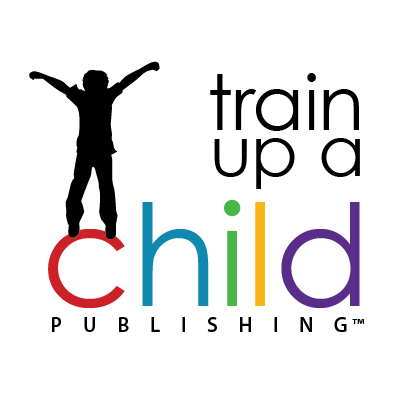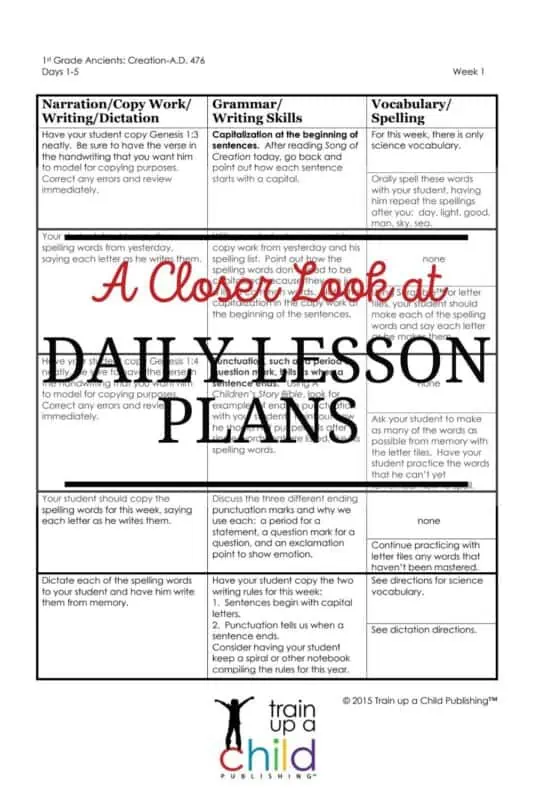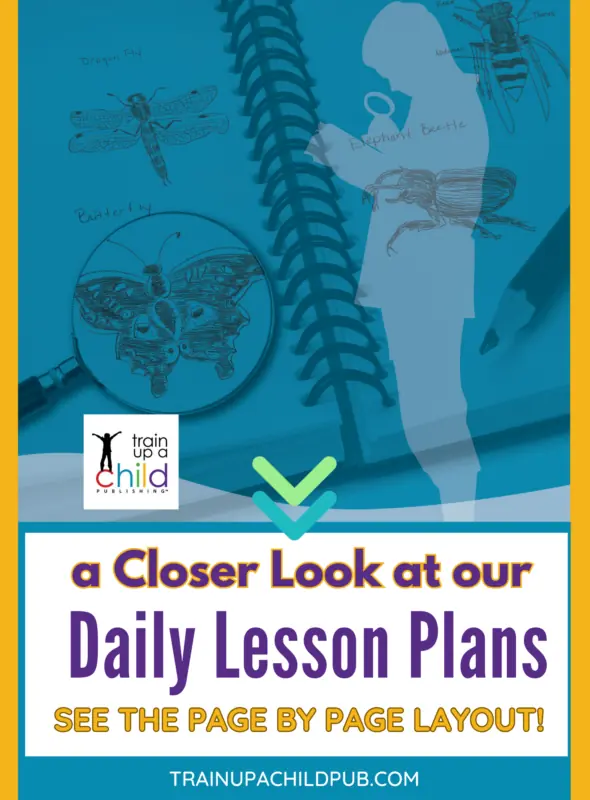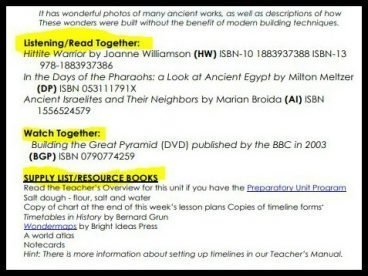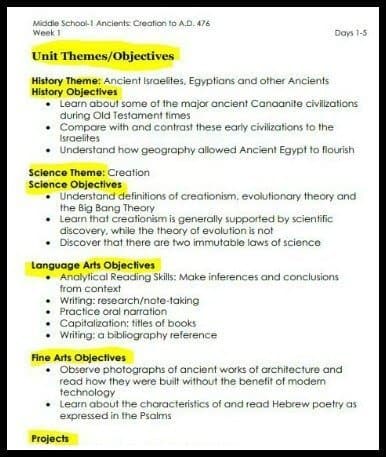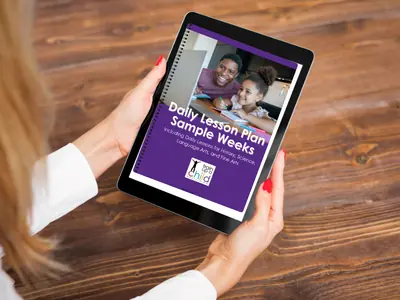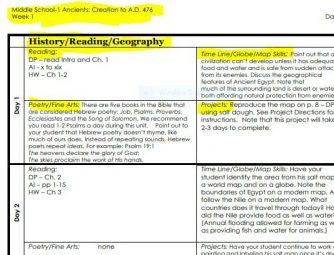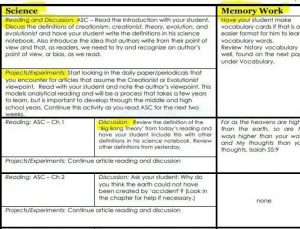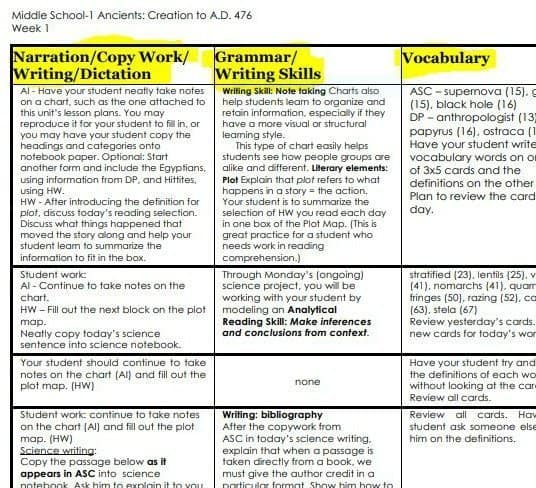A Closer Look at Our Daily Lesson Plans Layout
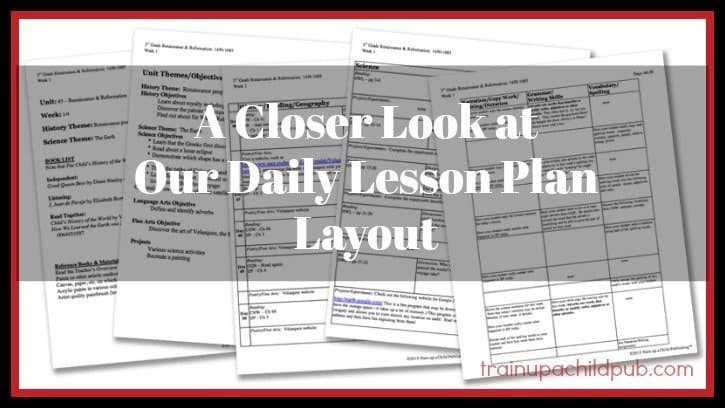
We get regular questions asking if we would describe our Daily Lesson Plans layout, so I’m answering it today here.
I’m looking at your curriculum, but I need more information. Could you explain the daily lesson plans layout and exactly what subjects they cover? Thank you, Rachel
Of course, I told Rachel I’d be happy to tell her more about our Daily Lesson Plans Layout.
In case you’ve been wondering about this as well, below is a page-by-page look at our Daily Lesson Plans layout and what subjects we cover on each page.
Note: We show our Middle School Daily Lesson Plans in the graphics below. However, our other Daily Lesson Plans grade levels have exactly the same layout.
Why and How we Created Our Daily Lesson Plans
We initially created our Daily Lesson Plans because our Unit Study Tools homeschool moms asked us to! They loved our Unit Study Tools…
But some of our Unit Study Tools homeschool moms wanted more structure than our Unit Study Tools provided.
Especially if they were homeschooling newbies.
They said, ” We want an open-and-go version of the Unit Study Tools! Can you make that for us?
They wanted:
So that’s what we did. We used our Unit Study Tools to create the most simple and easy-to-use Daily Lesson Plans.
So, Here’s our Daily Lesson Plans Layout
Below are screenshots of each page of the first week of the Middle School Daily Lesson Plans, with an explanation of the layout of each page. You can print the one-week sample here and follow along if that’s easier.
Page 1 of our Middle School Daily Lesson Plans layout
At the top left of the page is the header, which you’ll find on every page of the plans. No matter where you are in your school year, you’ll know the age level you’re teaching (Middle School) the unit you’re on (Ancients), and which week of the unit you are in (Week 1).
On the top right are the days in the school year that this week covers.
The days are numbered cumulatively throughout the school year, so you don’t have to worry if you don’t do school Monday through Friday every week.
If you take a day or week off when a stomach bug goes through the house, you can easily pick up right where you left off.
The Daily Lesson Plan page layout includes the main headings of Unit, Week, History Theme, and Science Theme for the week.
The Booklist follows and is divided into Independent Readers and Listening books. Listening books might be audio books or family read-alouds.
Next is the bottom of the first page showing the Listening/Read Together books, and there is a “Watch Together” heading for this particular week if there’s a DVD or streaming option.
A Supply List/Resource Books list for that week lets you know what you need to complete that particular week’s lessons. It also includes any supplies needed to do the projects listed for that week.
Note that the resource books can be considered optional. Often they share a type of book rather than a specific title — such as “a world atlas,” on this list.
Page 2 of our Middle School Daily Lesson Plans layout
We call the second page the Themes and Objectives page. This page shows you exactly what your objectives are for every week in history, science, language arts, and fine arts.
Note: We cover geography with history because it ties in better there.
Knowing what you are covering up front and your objectives for each subject gives you a clear road map for each week.
Additionally, we list projects for the week on this page.
Page 3 Now, we get to the good part — the actual daily lessons!
Page 3 begins your student’s lessons, starting with History, Reading, and Geography. We call this the History Page but integrate all three subjects on this page. Here you’ll see each day’s reading assignment and any discussion or narration prompts on the right.
At the bottom left of each day’s assignment, you’ll find a block for a Poetry and/or Fine Arts assignment and a Project assignment to the right. Note that not all of these boxes will be filled in each day. We tried to assign tasks as they related to the subject rather than listing “busy work” just to fill a block.
And of course, please don’t feel as though your child has to complete every assignment just as it’s written. We tell you in the lesson plans how to simplify assignments for a younger student, but please use your judgment. No matter how great it might be, homeschool curriculum is a tool. Remember that you know your child(ren) best, so you can modify, add to, or leave out whatever assignments you need to!
Page 4 Science and Memory Work
Page 4 is the Science and Memory Work Page. The first science block includes any science reading for the day and related discussion.
We list Projects and Experiments under the first block that pertain to that day’s science reading.
Also, on the right of these two blocks, we list Memory Work for the day. (Unless we need to squeeze some vocab in like we did in this example!)
Page 5: the Language Arts Page
Page 5 is the Language Arts Page, since here is where we might suggest a written narration, particular copy work from a book your student is reading, or perhaps dictation over a certain passage.
In the second column, your kids will practice Grammar and Writing Skills. Vocabulary lists and lessons are located in the third column.
In our younger levels of Daily Lesson Plans, you’ll also find Spelling Words in the third column. Generally, Middle School and High School students learn to spell best when you note misspellings in their writing.
Note that even though this is the Language Arts page, we include Poetry on the History page because the poetry we read in the daily lesson plans is usually integrated with the history you’re studying.
Our Daily Lesson Plan layouts is not complete without Supplemental Pages
Depending upon the unit, you may also have extra pages at the end of these usual pages. Supplemental pages might include project directions, a chart to use for taking reading notes, or more.
Sometimes, we provide additional background or reference information for you to read about a particular event or person to help you better understand it. If we have additional information to support you as the teacher, we put it at the end of the week’s pages.
Of course, feel free to share this extra background information with your students!
Hopefully, that fully answers Rachel’s question about our Daily Lesson Plan layout and any questions you might have. To see and download full week samples of all of our daily lesson Plans, click on the graphic below!
Happy Homeschooling!

.
